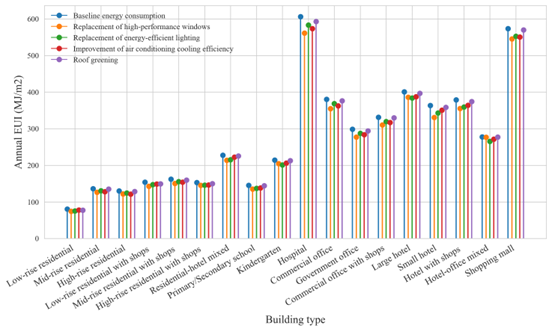A method for urban building type identification and energy saving potential evaluation
DOI:
https://doi.org/10.18686/cest352Keywords:
urban buildings; GIS data; spatial analysis; XGBoost; energy consumption simulation; building energy efficiencyAbstract
With the rapid acceleration of urbanization and the continuous growth of the urban population, urban energy consumption is projected to rise even more. Quantitative analysis of urban building energy is not only conducive to the formulation of relevant policies and evaluation standards, but also can promote energy conservation and emission reduction in urban buildings. However, current urban building energy simulation faces challenges in obtaining detailed building data. Especially, the complexity and diversity of building types, along with the large number of buildings, making it difficult to know the situation of each building type in urban areas. This paper combines spatial analysis methods with the XGBoost (eXtreme Gradient Boosting) model, utilizing GIS data such as building footprint, POI (Point of Interest), AOI (Area of Interest), and land use data, to achieve the identification and classification of 86.83% of buildings in Shenzhen, with an identification accuracy rate of 84.17%. Based on this, the study establishes 18 types of typical building prototype models and conducts energy consumption simulation and energy-saving potential assessment for buildings in Shenzhen, providing a scientific basis for energy conservation and carbon reduction in urban buildings. The research results indicate that among four energy-saving measures, high-performance window retrofitting has the most significant energy-saving effect, with an energy-saving rate of 6.2%; the energy-saving effects of improving the energy efficiency of air conditioning systems and replacing energy-saving lighting are equivalent, with energy-saving rates of 4.82% and 4.14%, respectively; whereas green roofs have a relatively smaller effect on building energy conservation, with an energy-saving rate of 1.27%.

Downloads
Published
How to Cite
Issue
Section
License
Copyright (c) 2025 Author(s)

This work is licensed under a Creative Commons Attribution 4.0 International License.
References
1. Mei S, Liu Z, Liu X. Research progress and applications of transcritical carbon dioxide heat pumps: A review. Clean Energy Science and Technology. 2023; 1(2). doi: 10.18686/cest.v1i2.118 DOI: https://doi.org/10.18686/cest.v1i2.118
2. Luo Z, Lin X, Wu Y, et al. Role of energy value chain in carbon neutrality: A review. Clean Energy Science and Technology. 2024; 2(4): 192. doi: 10.18686/cest.v2i4.192 DOI: https://doi.org/10.18686/cest.v2i4.192
3. Building Energy Consumption and Carbon Emission Data Committee of China Building Energy Conservation Association. Research Report on Carbon Emission in Urban and Rural Construction (2024 edition) (Chinese). Chongqing. Building Energy Consumption and Carbon Emission Data Committee of China Building Energy Conservation Association; 2024.
4. Yang X, Wang R, Zhang Z, et al. Optimal control method for flexible loads in thermally activated buildings. Clean Energy Science and Technology. 2025; 3(1): 334. doi: 10.18686/cest334 DOI: https://doi.org/10.18686/cest334
5. Marouani I. Contribution of renewable energy technologies in combating phenomenon of global warming and minimizing GHG emissions. Clean Energy Science and Technology. 2024; 2(2): 164. doi: 10.18686/cest.v2i2.164 DOI: https://doi.org/10.18686/cest.v2i2.164
6. Swan LG, Ugursal VI. Modeling of end-use energy consumption in the residential sector: A review of modeling techniques. Renewable and Sustainable Energy Reviews. 2009; 13(8): 1819–1835. doi: 10.1016/j.rser.2008.09.033 DOI: https://doi.org/10.1016/j.rser.2008.09.033
7. Lei W, Zhang Y, Li J, et al. Review of Bottom-Up Urban Building Energy Model (Chinese). Building Energy Efficiency. 2023; 51(09): 108–113.
8. Li Y, Wu Y, Wang L, et al. A Comparative Study of Urban Energy Consumption Simulation Methods (Chinese). Urban Planning International. 2020; 35(02): 80–86.
9. Deru M, Field K, Studer D, et al. U.S. Department of Energy Commercial Reference Building Models of the National Building Stock. National Renewable Energy Laboratory. 2011; 1–47. DOI: https://doi.org/10.2172/1009264
10. TABULA Project Team. Use of Building Typologies for Energy Performance Assessment of National Building Stocks. Institut Wohnen und Umwelt GmbH; 2010.
11. Gui C, Yan D, Guo S, et al. Development of prototype building model in Beijing based on actual energy consumption. In: Proceedings of the 11th International Symposium on Heating, Ventilation and Air Conditioning (ISHVAC 2019). 2019; Harbin, China. DOI: https://doi.org/10.1007/978-981-13-9528-4_120
12. An J, Wu Y, Gui C, et al. Chinese prototype building models for simulating the energy performance of the nationwide building stock. Building Simulation. 2023; 16(8): 1559–1582. DOI: https://doi.org/10.1007/s12273-023-1058-5
13. Chu G, Li M, Wang X. Integrating Height Features for Multi-scale Urban Building Type Classification from High-Resolution Remote Sensing Images (Chinese). Journal of Earth Information Science. 2021; 23(11): 2073–2085.
14. Chen Y. Research on the three-dimensional identification technology of multi-scale urban building types (Chinese). Science and Technology & Innovation. 2024; (07): 182–184.
15. Zhuo L, Shi Q, Zhang C, et al. Identifying Building Functions from the Spatiotemporal Population Density and the Interactions of People among Buildings. Isprs International Journal of Geo-Information. 2019; 8(6). DOI: https://doi.org/10.3390/ijgi8060247
16. Zhang X, Liu X, Chen K, et al. Inferring building function: A novel geo-aware neural network supporting building-level function classification. Sustainable Cities and Society. 2023; 89. DOI: https://doi.org/10.1016/j.scs.2022.104349
17. Deng Z, Chen Y, Pan X, et al. Integrating GIS-Based Point of Interest and Community Boundary Datasets for Urban Building Energy Modeling. Energies. 2021; 14(4): 1049. DOI: https://doi.org/10.3390/en14041049
18. Chen T, Carlos. XGBoost: A scalable tree boosting system. In: Proceedings of the 22nd ACM SIGKDD international conference on knowledge discovery and data mining. 2016. pp. 785–794. DOI: https://doi.org/10.1145/2939672.2939785
19. Zheng Y, Zhang X, Ou J, et al. Identifying building function using multisource data: A case study of China’s three major urban agglomerations. Sustainable Cities and (Dutta and Samanta 2020) Society. 2024; 108. DOI: https://doi.org/10.1016/j.scs.2024.105498
20. Ministry of Education, Ministry of Housing and Urban-Rural Development. Notice of the Ministry of Education and the Ministry of Housing and Urban-Rural Development on the issuance of the “Kindergarten Standard Design Sample” (Chinese). Ministry of Education, Ministry of Housing and Urban-Rural Development; 2019.
21. Shenzhen Municipal Housing and Construction Bureau. Design Code for Energy Efficiency of Public Buildings (Technical Code of Shenzhen Special Economic Zone) SJG 44-2018 (Chinese). Shenzhen Municipal Housing and Construction Bureau; 2018.
22. Shenzhen Municipal Housing and Construction Bureau. Design Code for Energy Efficiency of Residential Buildings (Technical Code of Shenzhen Special Economic Zone) SJG 45-2018 (Chinese). Shenzhen Municipal Housing and Construction Bureau; 2018.
23. Wang H. Applicability analysis of energy saving renovation measures for existing old residential buildings in Guangzhou (Chinese). Foshan Ceramics. 2023; 33(11): 96–98.
24. Dutta A, Samanta A. Determining Factor/s of Window Glazing Regarding Reduction in Electrical Energy Consumption. Journal of Energy Resources Technology-Transactions of the Asme.2020; 142(3): 032101. DOI: https://doi.org/10.1115/1.4044888
25. Yu Q. Virescence Energy-saving Reconstruction of Old Building Roof in Shenzhen City (Chinese). Huazhong Architecture. 2008; 26(5): 96–97,105.
26. Zhao S, He Y. Energy-saving effect of seven plants for roof insulation in Summer (Chinese). Building Energy Efficiency. 2018; 46(03): 40–43.
27. China National Building Waterproof Association. Technical specification for green roof JGJ 155-2013 (Chinese). Beijing: China. Architecture & Building Press; 2013.
28. Ministry of Housing and Urban-Rural Development. Standard for lighting design of buildings GB/T50034-2024 (Chinese). Beijing: China Architecture Publishing & Media Co., Ltd.; 2024.
29. Ministry of Housing and Urban-Rural Development. Technical standard for nearly zero energy buildings GB/T51350-2019 (Chinese). Beijing: China Architecture & Building Press; 2019.
30. Ministry of Housing and Urban-Rural Development. Uniform standard for design of civil buildings GB 50352-2019 (Chinese). Beijing: China Architecture & Building Press; 2019.
31. Wang L, Gu H, Du Q. Statistical analysis of energy consumption of civil buildings in Shenzhen in 2021 (Chinese). Housing Real Estate. 2023; (11): 49–53.
32. Zheng X, Zhou J, Wang Can. Research on the Urban Cooling and Energy Saving Effect of Green Roofs (Chinese). Ecological Economy. 2021; 37(02): 22.




.jpg)
.jpg)

